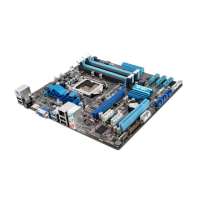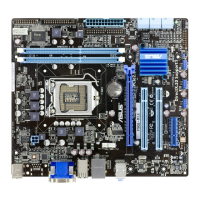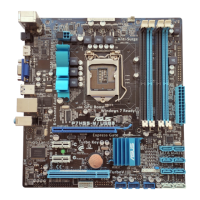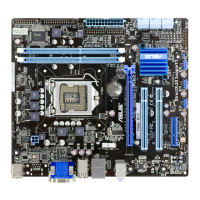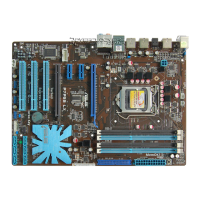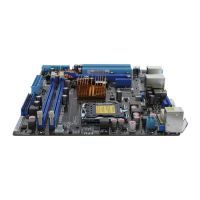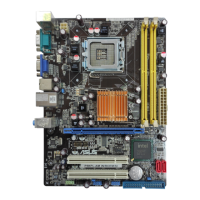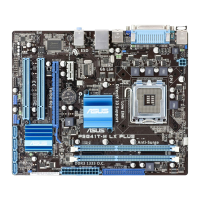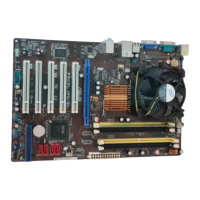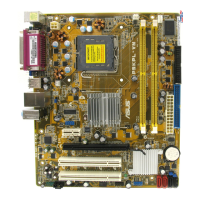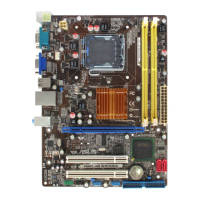Do you have a question about the Asus P7H55-M SI and is the answer not in the manual?
Precautions before installing components or changing motherboard settings.
Overview of motherboard layout, components, and connectors.
Diagram showing the physical placement of motherboard components.
List and description of motherboard connectors, jumpers, slots, and LEDs.
Details about the LGA1156 socket and supported Intel processors.
Information on DDR3 DIMM sockets and memory configuration.
Introduction to the motherboard's DDR3 DIMM sockets and their physical characteristics.
Guidelines for installing and configuring memory modules for dual-channel operation.
Description of various expansion slots like PCI and PCI Express.
Step-by-step instructions for installing expansion cards into the motherboard slots.
Steps to configure installed expansion cards via BIOS settings and drivers.
Details on the types of cards supported by the motherboard's PCI slots.
Information on cards compatible with the PCI Express x1 slot.
Information on graphics cards compatible with the PCI Express x16 slot.
Explanation of jumper functions, including clearing RTC RAM.
Procedure to clear CMOS settings using the CLRTC jumper.
Details on rear panel and internal connectors for peripherals.
Description and diagram of all rear panel I/O ports.
Detailed information on internal motherboard connectors for various components.
Information on installing operating systems and using the support DVD.
Guidelines for installing compatible Windows OS versions onto the motherboard.
Details on the content and usage of the motherboard's support DVD.
Guide to managing, saving, and updating the system BIOS.
Using the ASUS Update utility to manage and update the BIOS in Windows.
Updating the BIOS using the EZ Flash 2 utility without an operating system.
Updating the BIOS in a DOS environment using the BIOS Updater utility.
Recovering a corrupted BIOS file using the CrashFree BIOS utility.
Instructions on how to enter and navigate the BIOS setup program.
Overview of system information displayed in the BIOS main menu.
Setting the system time within the BIOS.
Setting the system date within the BIOS.
Configuration option for the installed floppy drive type.
Selecting the display language for the BIOS interface.
Viewing and configuring information for SATA devices.
Configuring advanced SATA device settings and operational modes.
Displays a summary of the system's hardware specifications.
Settings for CPU, chipset, and other system devices.
Settings related to CPU features, performance, and power management.
Advanced chipset settings including DRAM frequency and graphics configuration.
Enabling or disabling onboard devices like audio, LAN, and IDE controllers.
Settings for USB functions, legacy support, and EHCI hand-off.
Settings for PCI/PnP devices, including IRQ and DMA resource allocation.
Settings for Trusted Platform Module (TPM) features for enhanced security.
Settings for Intel Virtualization Technology for Directed I/O.
Settings related to Advanced Power Management (APM) and ACPI states.
Configuration of system sleep states (ACPI S1, S3, or OS detection).
Option to add more tables for ACPI 2.0 specifications.
Enabling or disabling ACPI support in the ASIC.
Enabling or disabling the motherboard's anti-surge protection feature.
Configuration of power management features like wake-on events.
Monitoring system temperatures, fan speeds, and voltages.
Options for configuring system boot devices and sequence.
Setting the sequence of devices for system boot.
Configuring quick boot and full-screen logo display features.
Setting supervisor and user passwords for BIOS access and restrictions.
Access to special function utilities like ASUS EZ Flash 2.
Utility for flashing the BIOS, supporting FAT and NTFS media.
Options for saving, discarding, or loading BIOS settings.
Saving current BIOS configuration changes and exiting setup.
Discarding all BIOS configuration changes and exiting setup.
Loading the default BIOS settings for system compatibility.
Details on the LGA1156 socket and supported Intel processors.
Information on the Intel H55 Express Chipset.
Specifications for DDR3 memory modules, capacity, and architecture.
Types and number of expansion slots (PCIe, PCI) available on the motherboard.
Integrated Intel Graphics Media Accelerator capabilities and resolutions.
Details on SATA and IDE connectors for storage devices.
Specifications for the onboard Gigabit LAN controller.
Information on the onboard High Definition Audio CODEC.
Details on the number and type of USB 2.0 ports available.
List of proprietary ASUS features like Q-Fan and EZ Flash.
Enumeration of ports located on the motherboard's rear I/O panel.
List and description of internal connectors for system components.
Technical details about the onboard BIOS chip and features.
System manageability features like WOL and PXE.
List of accessories included with the motherboard package.
Content details of the motherboard's support DVD.
Physical dimensions of the motherboard (uATX).
| Form Factor | Micro ATX |
|---|---|
| Chipset | Intel H55 |
| CPU Socket | LGA 1156 |
| Memory Type | DDR3 |
| Max Memory | 16 GB |
| PCIe x16 Slots | 1 |
| PCIe x1 Slots | 2 |
| PCI Slots | 1 |
| LAN | Realtek 8112L Gigabit LAN controller |
| USB Ports | 12 x USB 2.0 |
| Audio | 8-Channel High Definition Audio |
| Video Outputs | DVI, VGA |
| Memory Slots | 4 |

